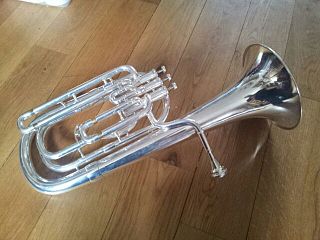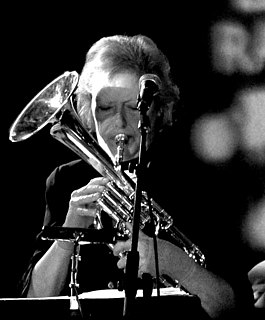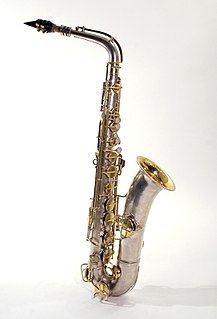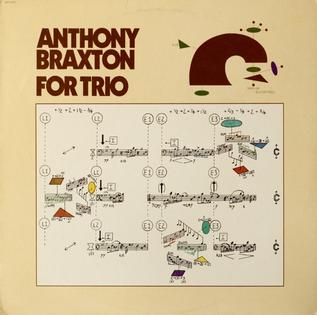Related Research Articles
In music, a quartet or quartette is an ensemble of four singers or instrumental performers; or a musical composition for four voices or instruments.

The saxophone is a family of woodwind instruments usually made of brass and played with a single-reed mouthpiece. Although most saxophones are made from brass, they are categorized as woodwind instruments, because sound is produced by an oscillating reed, traditionally made out of woody cane, rather than lips vibrating in a mouthpiece cup as with the brass instrument family. As with the other woodwind instruments, the pitch of the note being played is controlled by covering holes in the body tube to control the resonant frequency of the air column by changing the effective length of the tube. The player covers or uncovers the holes by pressing keys.

The ukulele or ukelele is a member of the lute family of instruments. It generally employs four nylon strings.

A clef is a musical symbol used to indicate the pitch of written notes. Placed on a stave, it indicates the name and pitch of the notes on one of the lines. This line serves as a reference point by which the names of the notes on any other line or space of the stave may be determined.

The baritone horn, or sometimes just called baritone, is a low-pitched brass instrument in the saxhorn family. It is a piston-valve brass instrument with a bore that is mostly conical but it has a narrower bore than the similarly pitched euphonium. It uses a wide-rimmed cup mouthpiece like that of its peers, the trombone and euphonium. Like the trombone and the euphonium, the baritone horn can be considered either a transposing or non-transposing instrument.
Throughout history, various methods of musical instrument classification have been used. The most commonly used system divides instruments into string instruments, woodwind instruments, brass instruments and percussion instruments; however, other schemes have been devised.

The tenor horn is a brass instrument in the saxhorn family, and is usually pitched in E♭. It has a bore that is mostly conical, like the flugelhorn and baritone horn, and normally uses a deep, cornet-like mouthpiece.
Contrabass refers to several musical instruments of very low pitch—generally one octave below bass register instruments. While the term most commonly refers to the double bass, many other instruments in the contrabass register exist.

The tenor saxophone is a medium-sized member of the saxophone family, a group of instruments invented by Adolphe Sax in the 1840s. The tenor and the alto are the two most commonly used saxophones. The tenor is pitched in the key of B♭ (while the alto is pitched in the key of E♭), and written as a transposing instrument in the treble clef, sounding an octave and a major second lower than the written pitch. Modern tenor saxophones which have a high F♯ key have a range from A♭2 to E5 (concert) and are therefore pitched one octave below the soprano saxophone. People who play the tenor saxophone are known as "tenor saxophonists", "tenor sax players", or "saxophonists".

The baritone saxophone or "bari sax" is one of the larger members of the saxophone family, only being smaller than the bass, contrabass and subcontrabass saxophones. It is the lowest-pitched saxophone in common use. The baritone saxophone uses a mouthpiece, reed, and ligature in order to produce sound. It is larger than the tenor, alto and soprano saxophones, which are the other commonly found members of the family. The baritone saxophone is commonly used in concert bands, chamber music, military bands, jazz. It also is occasionally employed in marching bands, though less frequently than other saxophones due to its size and weight.

The soprano saxophone is a higher-register variety of the saxophone, a woodwind instrument, invented in the 1840s. The soprano is the third smallest member of the saxophone family, which consists of the soprillo, sopranino, soprano, alto, tenor, baritone, bass, contrabass saxophone and tubax. Soprano saxophones are the smallest saxophone in common use.

The sopranino saxophone is one of the smallest members of the saxophone family. It is tuned in the key of E♭, and sounds an octave higher than the alto saxophone. The sopranino saxophone has a sweet sound and although it is one of the least common of the saxophones in regular use today, it is still being produced by several of the major musical manufacturing companies. Due to their small size, sopraninos are not usually curved like other saxophones. Orsi, however, does make curved sopranino saxophones.

The C melody saxophone is a saxophone pitched in the key of C, one whole step above the B-flat tenor saxophone. In the UK it is sometimes referred to as a "C tenor", and in France as a "tenor en ut". The C melody was part of the series of saxophones pitched in C and F intended by the instrument's inventor, Adolphe Sax, for orchestral use. The instrument enjoyed popularity in the early 1900s, perhaps most prominently used by Rudy Wiedoeft and Frankie Trumbauer, but is now uncommon.

Yanagisawa Wind Instruments Co., Ltd. is a Japanese woodwind instrument manufacturing company known for its range of professional grade saxophones. Along with Yamaha they are one of the leading manufacturers of saxophones in their country of origin. The company currently manufactures sopranino, soprano, alto, tenor and baritone saxophones.

On a stringed instrument, a break in an otherwise ascending order of string pitches is known as a re-entry. A re-entrant tuning, therefore, is a tuning where the strings are not all ordered from the lowest pitch to the highest pitch.

For Trio is an album by American jazz saxophonist and composer Anthony Braxton recorded in 1977 and released on the Arista label. The album features two recordings of the same composition by Braxton in two separate trios and was subsequently included on The Complete Arista Recordings of Anthony Braxton released by Mosaic Records in 2008.
References
- ↑ Maz, Barry. "Ohana 'O'Nino' Sopranissimo Ukulele - REVIEW". GOT A UKULELE - Ukulele reviews and beginners tips.
| This music theory article is a stub. You can help Wikipedia by expanding it. |